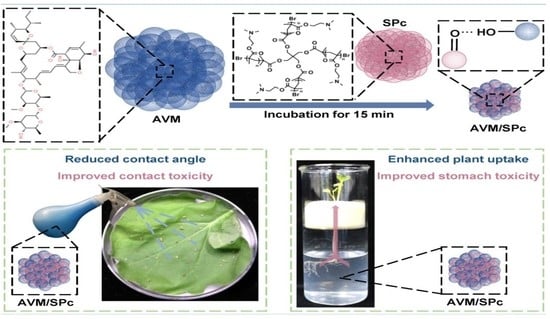A Star Polyamine-Based Nanocarrier Delivery System for Enhanced Avermectin Contact and Stomach Toxicity against Green Peach Aphids
Abstract
:1. Introduction
2. Materials and Methods
2.1. Chemical Reagents
2.2. SPc Construction
2.3. Preparation of AVM Nano-Delivery System
2.4. Loading Capacity Measurement
2.5. Complex Morphology Characterization and Particle Size Measurement
2.6. Isothermal Titration Calorimetry (ITC) Assay
2.7. Contact Angle Analysis
2.8. Stomach Toxicity Assay through Root Application
2.9. Contact Toxicity Assay through Immersion Method
2.10. Data Analysis
3. Results and Discussion
3.1. Ultraviolet Absorption of AVM/SPc Complex and Loading Capacity
3.2. Characterization of Nanoscale AVM/SPc Complex
3.3. Self-Assembly of AVM/SPc Complex through Hydrogen Bond and van der Waals Forces
3.4. Reduced Contact Angle of AVM/SPc Complex
3.5. Improved Stomach Toxicity of SPc-Loaded AVM toward Green Peach Aphids
3.6. Improved Contact Toxicity of SPc-Loaded AVM toward Green Peach Aphids
4. Conclusions
Author Contributions
Funding
Institutional Review Board Statement
Informed Consent Statement
Data Availability Statement
Conflicts of Interest
References
- Kumar, S.; Nehra, M.; Dilbaghi, N.; Marrazza, G.; Hassan, A.A.; Kim, K.H. Nano-based smart pesticide formulations: Emerging opportunities for agriculture. J. Control. Release 2019, 294, 131–153. [Google Scholar] [CrossRef] [PubMed]
- Lykogianni, M.; Bempelou, E.; Karamaouna, F.; Aliferis, K.A. Do pesticides promote or hinder sustainability in agriculture? The challenge of sustainable use of pesticides in modern agriculture. Sci. Total Environ. 2021, 795, 148625. [Google Scholar] [CrossRef] [PubMed]
- Nuruzzaman, M.; Rahman, M.M.; Liu, Y.; Naidu, R. Nanoencapsulation, nano-guard for pesticides: A new window for safe application. J. Agric. Food Chem. 2016, 64, 1447–1483. [Google Scholar] [CrossRef]
- Tang, F.H.M.; Lenzen, M.; McBratney, A.; Maggi, F. Risk of pesticide pollution at the global scale. Nat. Geosci. 2021, 14, 206–210. [Google Scholar] [CrossRef]
- Fu, H.; Tan, P.; Wang, R.; Li, S.; Liu, H.; Yang, Y.; Wu, Z. Advances in organophosphorus pesticides pollution: Current status and challenges in ecotoxicological, sustainable agriculture, and degradation strategies. J. Hazard. Mater. 2022, 424, 127494. [Google Scholar] [CrossRef]
- Zhao, X.; Cui, H.; Wang, Y.; Sun, C.; Cui, B.; Zeng, Z. Development strategies and prospects of nano-based smart pesticide formulation. J. Agric. Food Chem. 2017, 66, 6504–6512. [Google Scholar] [CrossRef] [PubMed]
- Tong, Y.; Wu, Y.; Zhao, C.; Xu, Y.; Lu, J.; Xiang, S.; Zong, F.; Wu, X. Polymeric nanoparticles as a metolachlor carrier: Water-based formulation for hydrophobic pesticides and absorption by plants. J. Agric. Food Chem. 2017, 65, 7371–7378. [Google Scholar] [CrossRef]
- Slattery, M.; Harper, B.; Harper, S. Pesticide encapsulation at the nanoscale drives changes to the hydrophobic partitioning and toxicity of an active ingredient. Nanomaterials 2019, 9, 81. [Google Scholar] [CrossRef] [Green Version]
- Elabasy, A.; Shoaib, A.; Waqas, M.; Shi, Z.; Jiang, M. Cellulose nanocrystals loaded with thiamethoxam: Fabrication, characterization, and evaluation of insecticidal activity against Phenacoccus solenpsis Tinsley (Hemiptera: Pseudococcidae). Nanomaterials 2020, 10, 788. [Google Scholar] [CrossRef] [Green Version]
- Saleem, H.; Zaidi, S.J. Recent developments in the application of nanomaterials in agroecosystems. Nanomaterials 2020, 10, 2411. [Google Scholar] [CrossRef]
- Spanos, A.; Athanasiou, K.; Ioannou, A.; Fotopoulos, V.; Krasia-Christoforou, T. Functionalized magnetic nanomaterials in agricultural applications. Nanomaterials 2021, 11, 3106. [Google Scholar] [CrossRef] [PubMed]
- Cao, L.; Zhang, H.; Zhou, Z.; Xu, C.; Shan, Y.; Lin, Y.; Huang, Q. Fluorophore-free luminescent double-shelled hollow mesoporous silica nanoparticles as pesticide delivery vehicles. Nanoscale 2018, 10, 20354–20365. [Google Scholar] [CrossRef] [PubMed]
- Kah, M.; Tufenkji, N.; White, J.C. Nano-enabled strategies to enhance crop nutrition and protection. Nat. Nanotechnol. 2019, 14, 532–540. [Google Scholar] [CrossRef]
- Song, S.; Wang, Y.; Xie, J.; Sun, B.; Zhou, N.; Shen, H.; Shen, J. Carboxymethyl chitosan modified carbon nanoparticle for controlled emamectin benzoate delivery: Improved solubility, pH-responsive release, and sustainable pest control. ACS Appl. Mater. Inter. 2019, 11, 34258–34267. [Google Scholar] [CrossRef] [PubMed]
- Li, J.; Qian, J.; Xu, Y.; Yan, S.; Shen, J.; Yin, M. A facile-synthesized star polycation constructed as a highly efficient gene vector in pest management. ACS Sustain. Chem. Eng. 2019, 7, 6316–6322. [Google Scholar] [CrossRef]
- Wang, X.; Zheng, K.; Cheng, W.; Li, J.; Liang, X.; Shen, J.; Dou, D.; Yin, M.; Yan, S. Field application of star polymer-delivered chitosan to amplify plant defense against potato late blight. Chem. Eng. J. 2021, 417, 129327. [Google Scholar] [CrossRef]
- Ma, Z.; Zheng, Y.; Chao, Z.; Chen, H.; Zhang, Y.; Yin, M.; Shen, J.; Yan, S. Visualization of the process of a nanocarrier-mediated gene delivery: Stabilization, endocytosis and endosomal escape of genes for intracellular spreading. J. Nanobiotechnol. 2022, 20, 124. [Google Scholar] [CrossRef]
- Yan, S.; Hu, Q.; Jiang, Q.; Chen, H.; Wei, J.; Yin, M.; Du, X.; Shen, J. Simple osthole/nanocarrier pesticide efficiently controls both pests and diseases fulfilling the need of green production of strawberry. ACS Appl. Mater. Inter. 2021, 13, 36350–36360. [Google Scholar] [CrossRef]
- Yan, S.; Cheng, W.Y.; Han, Z.H.; Wang, D.; Yin, M.Z.; Du, X.G.; Shen, J. Nanometerization of thiamethoxam by a cationic star polymer nanocarrier efficiently enhances the contact and plant-uptake dependent stomach toxicity against green peach aphids. Pest Manag. Sci. 2021, 77, 1954–1962. [Google Scholar] [CrossRef]
- Jiang, Q.; Xie, Y.; Peng, M.; Wang, Z.; Li, T.; Yin, M.; Shen, J.; Yan, S. A nanocarrier pesticide delivery system with promising benefits in the case of dinotefuran: Strikingly enhanced bioactivity and reduced pesticide residue. Environ. Sci. Nano 2022, 9, 988–999. [Google Scholar] [CrossRef]
- Choi, H.Y.; Lim, H.S.; Park, K.H.; Kim, J.; Kim, W.G. Directed evolution of glycosyltransferase for enhanced efficiency of avermectin glucosylation. Appl. Microbiol. Biot. 2021, 105, 4599–4607. [Google Scholar] [CrossRef] [PubMed]
- Li, M.; Zhang, P.; Xu, W.; Yuan, J.; Li, Q.; Tao, L.; Li, Z.; Zhang, Y. Avermectin induces toxic effects in insect nontarget cells involves DNA damage and its associated programmed cell death. Comp. Biochem. Phys. C 2021, 249, 109130. [Google Scholar] [CrossRef] [PubMed]
- Hao, L.; Gong, L.; Chen, L.; Guan, M.; Zhou, H.; Qiu, S.; Wen, H.; Chen, H.; Zhou, X.; Akbulut, M. Composite pesticide nanocarriers involving functionalized boron nitride nanoplatelets for pH-responsive release and enhanced UV stability. Chem. Eng. J. 2020, 396, 125233. [Google Scholar] [CrossRef]
- Kaziem, A.E.; Gao, Y.; Zhang, Y.; Qin, X.; Xiao, Y.; Zhang, Y.; You, H.; Li, J.; He, S. α-amylase triggered carriers based on cyclodextrin anchored hollow mesoporous silica for enhancing insecticidal activity of avermectin against Plutella xylostella. J. Hazard. Mater. 2018, 359, 213–221. [Google Scholar] [CrossRef] [PubMed]
- Zhang, H.; Qin, H.; Li, L.; Zhou, X.; Wang, W.; Kan, C. Preparation and characterization of controlled-release avermectin/castor oil-based polyurethane nanoemulsions. J. Agri. Food Chem. 2018, 66, 6552–6560. [Google Scholar] [CrossRef]
- Lin, G.; Zhou, H.; Lian, J.; Chen, H.; Xu, H.; Zhou, X. Preparation of pH-responsive avermectin/feather keratin-hyaluronic acid with anti-UV and sustained-release properties. Colloids Surf. B Biointerfaces 2019, 175, 291–299. [Google Scholar] [CrossRef]
- Wen, H.; Zhou, H.; Hao, L.; Chen, H.; Xu, H.; Zhou, X. Enzyme cum pH dual-responsive controlled release of avermectin from functional polydopamine microcapsules. Colloids Surf. B Biointerfaces 2020, 186, 110699. [Google Scholar] [CrossRef]
- Chen, K.; Yuan, S.; Wang, D.; Liu, Y.; Chen, F.; Qi, D. Basic amino acid-modified lignin-based biomass adjuvants: Synthesis, emulsifying activity, ultraviolet protection, and controlled release of avermectin. Langmuir 2021, 37, 12179–12187. [Google Scholar] [CrossRef]
- Mo, D.; Li, X.; Chen, Y.; Jiang, Y.; Gan, C.; Zhang, Y.; Li, W.; Huang, Y.; Cui, J. Fabrication and evaluation of slow-release lignin-based avermectin nano-delivery system with UV-shielding property. Sci. Rep. 2021, 11, 23248. [Google Scholar] [CrossRef]
- Doyle, M.L. Characterization of binding interactions by isothermal titration calorimetry. Curr. Opin. Biotechnol. 1997, 8, 31–35. [Google Scholar] [CrossRef]
- Grolier, J.P.E.; Del Río, J.M. Isothermal titration calorimetry: A thermodynamic interpretation of measurements. J. Chem. Thermodyn. 2012, 55, 193–202. [Google Scholar] [CrossRef]
- Chen, L.; Zhou, H.; Hao, L.; Li, Z.; Xu, H.; Chen, H.; Zhou, X. Dialdehyde carboxymethyl cellulose-zein conjugate as water-based nanocarrier for improving the efficacy of pesticides. Ind. Crop. Prod. 2020, 150, 112358. [Google Scholar] [CrossRef]
- Zhu, H.; Shen, Y.; Cui, J.; Wang, A.; Li, N.; Wang, C.; Cui, B.; Sun, C.; Zhao, X.; Wang, C.; et al. Avermectin loaded carboxymethyl cellulose nanoparticles with stimuli-responsive and controlled release properties. Ind. Crops Prod. 2020, 152, 112497. [Google Scholar] [CrossRef]
- Xu, Z.N. A static contact angle algorithm for silicone rubber aging experiments. IEEE T. Power Deliver. 2013, 28, 491–498. [Google Scholar] [CrossRef]
- Yan, S.; Wang, W.X.; Shen, J. Reproductive polyphenism and its advantages in aphids: Switching between sexual and asexual reproduction. J. Integr. Agric. 2020, 19, 1447–1457. [Google Scholar] [CrossRef]
- Deng, D.; Duan, W.; Wang, H.; Zhang, K.; Guo, J.; Yuan, L.; Wang, L.; Wu, S. Assessment of the effects of lethal and sublethal exposure to dinotefuran on the wheat aphid Rhopalosiphum padi (Linnaeus). Ecotoxicology 2019, 28, 825–833. [Google Scholar] [CrossRef]
- Zhang, Y.; Ma, Z.; Zhou, H.; Chao, Z.; Yan, S.; Shen, J. Nanocarrier-delivered dsRNA suppresses wing development of green peach aphids. Insect Sci. 2021. [Google Scholar] [CrossRef]
- Gao, H.; Liu, M.; Zhou, X.; Liu, J.; Zhuo, Y.; Gou, Z.; Xu, B.; Zhang, W.; Liu, X.; Luo, A.; et al. Identification of avermectin-high-producing strains by high-throughput screening methods. Appl. Microbol. Biotechnol. 2010, 85, 1219–1225. [Google Scholar] [CrossRef] [Green Version]
- Wang, Y.; Xie, Y.H.; Jiang, Q.H.; Chen, H.T.; Ma, R.H.; Wang, Z.J.; Yin, M.Z.; Shen, J.; Yan, S. Efficient polymer-mediated delivery system for thiocyclam: Nanometerization remarkably improves the bioactivity toward green peach aphids. Insect Sci. 2022. [Google Scholar] [CrossRef]
- Yan, S.; Hu, Q.; Li, J.; Cao, Z.; Cai, C.; Yin, M.; Du, X.; Shen, J. A star polycation acts a drug nanocarrier to improve the toxicity and persistence of botanical pesticides. ACS Sustain. Chem. Eng. 2019, 7, 17406–17413. [Google Scholar] [CrossRef]
- Ross, P.D.; Subramanian, S. Thermodynamics of protein association reactions: Forces contributing to stability. Biochemistry 1981, 20, 3096–3102. [Google Scholar] [CrossRef] [PubMed]
- Holloway, P.J. Surface factors affecting the wetting of leaves. Pest Manag. Sci. 1970, 1, 156–163. [Google Scholar] [CrossRef]
- Müller, C.; Riederer, M. Plant surface properties in chemical ecology. J. Chem. Ecol. 2005, 31, 2621–2651. [Google Scholar] [CrossRef] [PubMed]
- Guan, W.; Tang, L.; Wang, Y.; Cui, H. Fabrication of an effective avermectin nanoemulsion using a cleavable succinic ester emulsifier. J. Agric. Food Chem. 2018, 66, 7568–7576. [Google Scholar] [CrossRef]
- Santos, C.A.M.D.; Santos, R.T.D.S.; Della’Vechia, J.F.; Griesang, F.; Polanczyk, R.A. Effect of addition of adjuvants on physical and chemical characteristics of Bt bioinsecticide mixture. Sci. Rep. 2019, 9, 12525. [Google Scholar] [CrossRef] [Green Version]
- Zhao, K.; Hu, J.; Ma, Y.; Wu, T.; Gao, Y.; Du, F. Topology-regulated pesticide retention on plant leaves through concave Janus carriers. ACS Sustain. Chem. Eng. 2019, 7, 13148–13156. [Google Scholar] [CrossRef]
- Chen, L.; Lin, Y.; Zhou, H.; Hao, L.; Chen, H.; Zhou, X. A stable polyamine-modified zein-based nanoformulation with high foliar affinity and lowered toxicity for sustained avermectin release. Pest Manag. Sci. 2021, 77, 3300–3312. [Google Scholar] [CrossRef]
- Jia, X.; Sheng, W.B.; Li, W.; Tong, Y.B.; Liu, Z.Y.; Zhou, F. Adhesive polydopamine coated avermectin microcapsules for prolonging foliar pesticide retention. ACS Appl. Mater. Inter. 2014, 6, 19552–19558. [Google Scholar] [CrossRef]
- Deecher, D.C.; Brezner, J.; Tanenbaum, S.W. Sublethal effects of avermectin and milbemycin on the gypsy moth (Lepidoptera: Lymantriidae). J. Econ. Entomol. 1990, 83, 710–714. [Google Scholar] [CrossRef]
- Gouamene-Lamine, C.N.; Yoon, K.S.; Clark, J.M. Differential susceptibility to abamectin and two bioactive avermectin analogs in abamectin-resistant and -susceptible strains of Colorado potato beetle, Leptinotarsa decemlineata (Say) (Coleoptera: Chrysomelidae). Pestic. Biochem. Physiol. 2003, 76, 15–23. [Google Scholar] [CrossRef]
- Lin, Y.Y.; Jin, T.; Jin, Q.A.; Wen, H.B.; Peng, Z.Q. Differential susceptibilities of Brontispa longissima (Coleoptera: Hispidae) to insecticides in Southeast Asia. J. Econ. Entomol. 2012, 105, 988–993. [Google Scholar] [CrossRef]
- Su, C.; Ji, Y.; Liu, S.; Gao, S.; Cao, S.; Xu, X.; Zhou, C.; Liu, Y. Fluorescence-labeled abamectin nanopesticide for comprehensive control of pinewood nematode and Monochamus alternatus Hope. ACS Sustain. Chem. Eng. 2020, 8, 16555–16564. [Google Scholar] [CrossRef]
- Wang, G.; Xiao, Y.; Xu, H.; Hu, P.; Liang, W.; Xie, L.; Jia, J. Development of multifunctional avermectin poly(succinimide) nanoparticles to improve bioactivity and transportation in rice. J. Agr. Food Chem. 2018, 66, 11244–11253. [Google Scholar] [CrossRef] [PubMed]
- Ma, Z.; Zhang., Y.; Li, M.; Chao, Z.; Du, X.; Yan, S.; Shen, J. A first greenhouse application of bacteria-expressed and nanocarrier-delivered RNA pesticide for Myzus persicae control. J. Pest Sci. 2022. [Google Scholar] [CrossRef]
- Yan, S.; Qian, J.; Cai, C.; Ma, Z.; Li, J.; Yin, M.; Ren, B.; Shen, J. Spray method application of transdermal dsRNA delivery system for efficient gene silencing and pest control on soybean aphid Aphis glycines. J. Pest Sci. 2020, 93, 449–459. [Google Scholar] [CrossRef]
- Zhang, D.X.; Wang, R.; Cao, H.; Luo, J.; Jing, T.F.; Li, B.X.; Mu, W.; Liu, F.; Hou, Y. Emamectin benzoate nanogel suspension constructed from poly(vinyl alcohol)-valine derivatives and lignosulfonate enhanced insecticidal efficacy. Colloid. Surface. B 2022, 209, 112166. [Google Scholar] [CrossRef]
- Dong, M.; Chen, D.; Che, L.; Gu, N.; Yin, M.; Du, X.; Shen, J.; Yan, S. Biotoxicity evaluation of a cationic star polymer on a predatory ladybird and cooperative pest control by polymer-delivered pesticides and ladybird. ACS Appl. Mater. Inter. 2022, 14, 6083–6092. [Google Scholar] [CrossRef]
- Li, M.; Ma, Z.; Peng, M.; Li, L.; Yin, M.; Yan, S.; Shen, J. A gene and drug co-delivery application helps to solve the short life disadvantage of RNA drug. Nano Today 2022, 43, 101452. [Google Scholar] [CrossRef]
- Yan, S.; Yin, H.; Li, N.; Chen, Y.; Ji, C.; Jiang, Q.; Du, J.; Yin, M.; Shen, J.; Zhang, J. Combination of a nanocarrier delivery system with genetic manipulation further improves pesticide efficiency: A case study with chlorfenapyr. Environ. Sci. Nano 2022. [Google Scholar] [CrossRef]
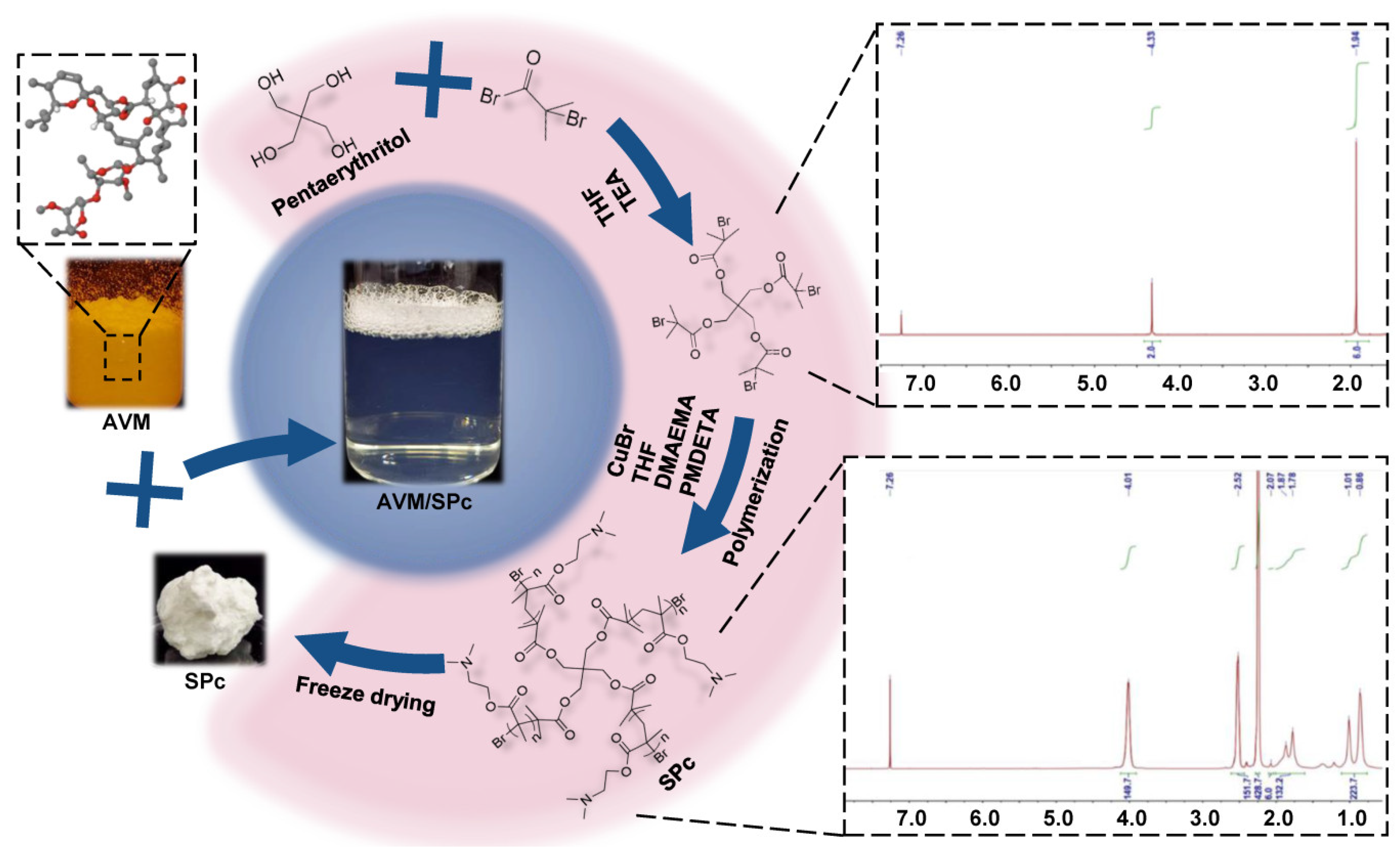

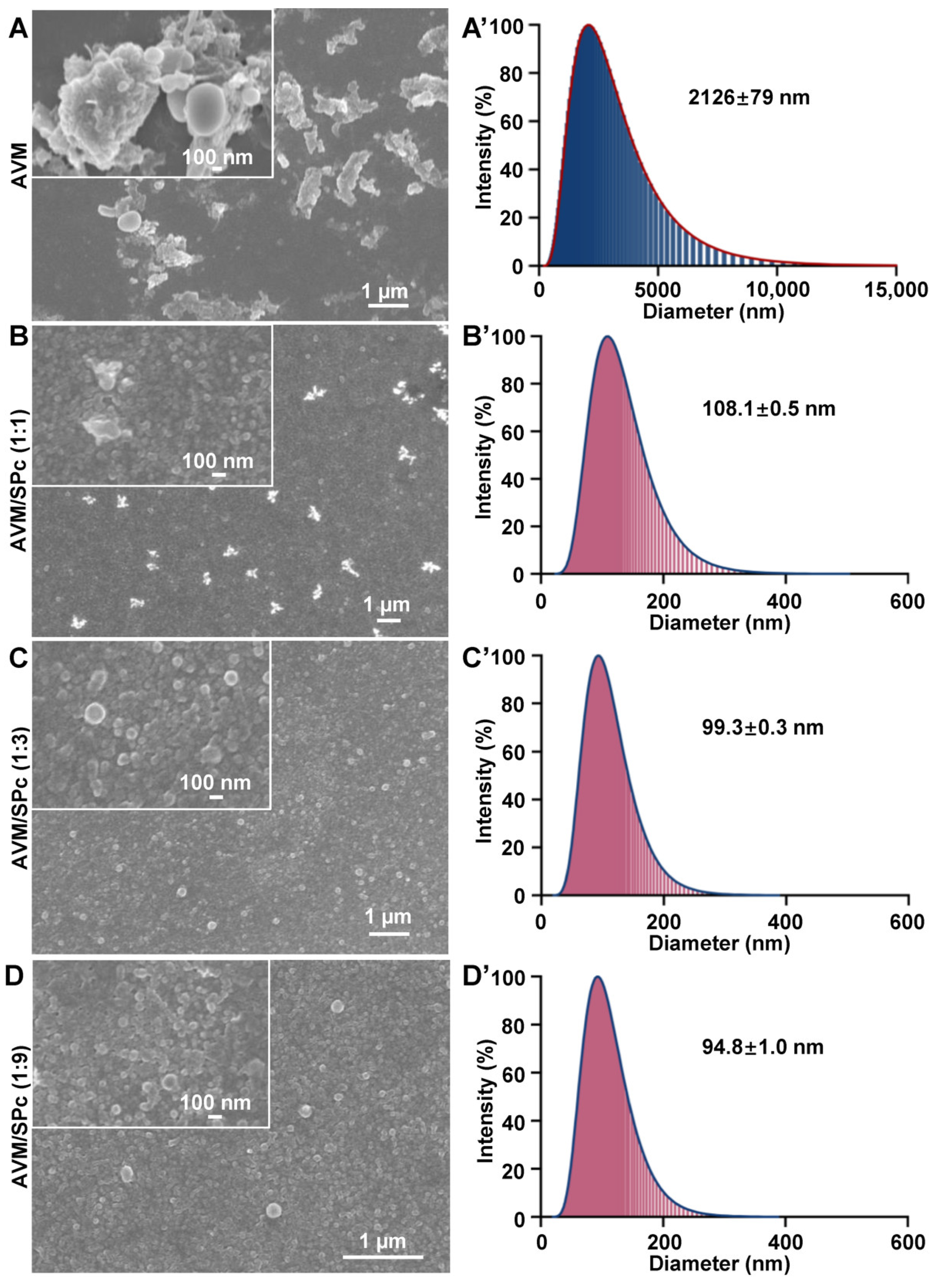

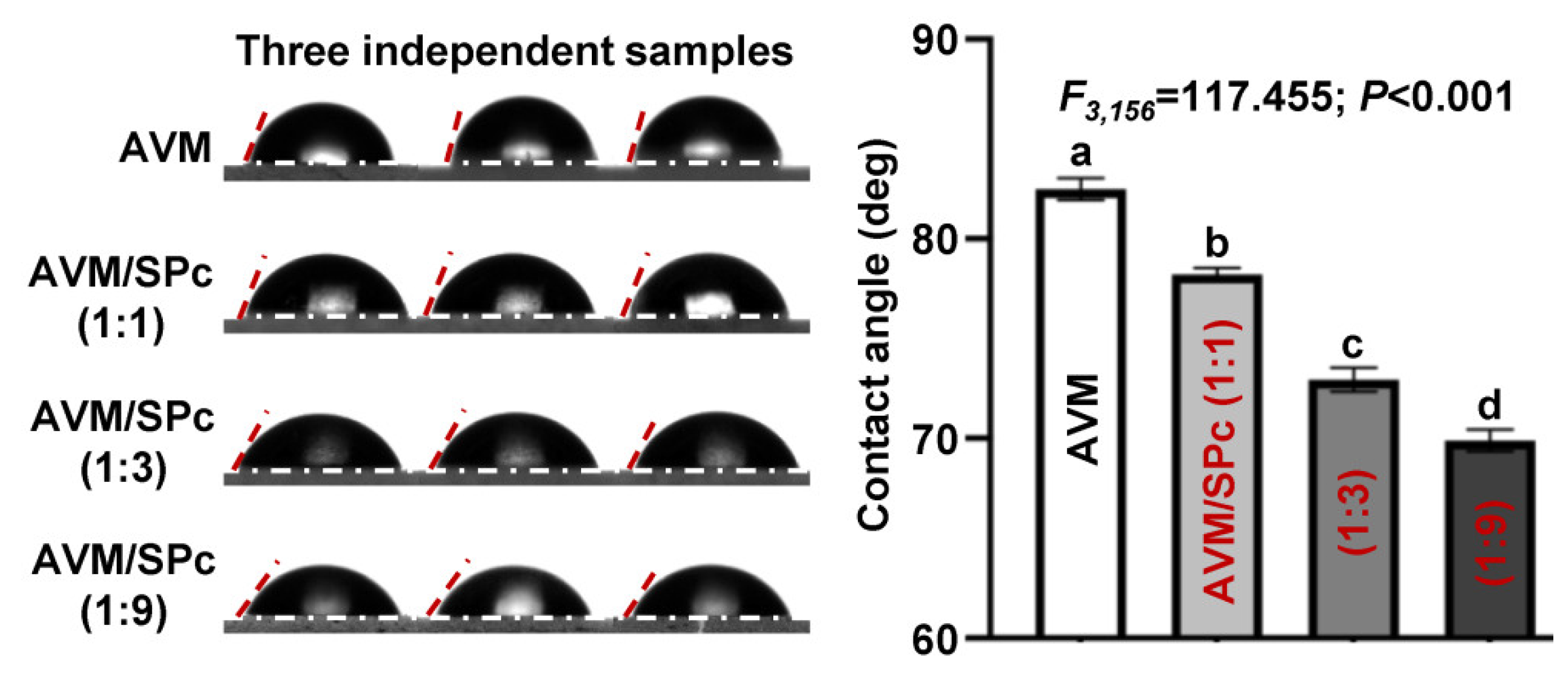

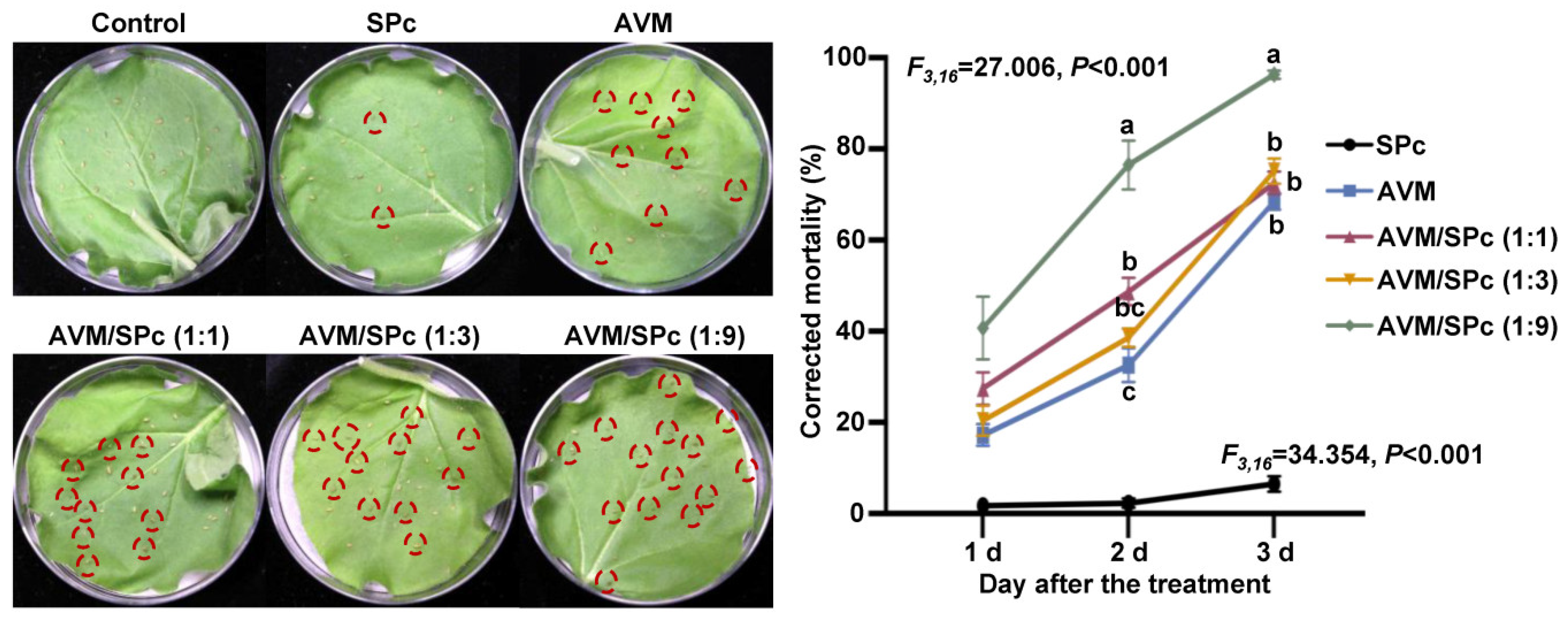
| Formulation | Mass Ratio | Sample Number | Polydispersity | Average Polydispersity | Size (nm) | Average Size (nm) |
|---|---|---|---|---|---|---|
| AVM | - | 1 | 0.361 | 0.428 ± 0.036 a | 2077 | 2126 ± 79 a |
| 2 | 0.440 | 2280 | ||||
| 3 | 0.483 | 2020 | ||||
| AVM/SPc complex | 1:1 | 1 | 0.149 | 0.135 ± 0.009 b | 108.6 | 108.1 ± 0.5 b |
| 2 | 0.139 | 108.6 | ||||
| 3 | 0.117 | 107.1 | ||||
| 1:3 | 1 | 0.091 | 0.092 ± 0.002 b | 99.9 | 99.3 ± 0.3 b | |
| 2 | 0.095 | 99.4 | ||||
| 3 | 0.089 | 98.7 | ||||
| 1:9 | 1 | 0.091 | 0.082 ± 0.010 b | 93.0 | 94.8 ± 1.0 b | |
| 2 | 0.063 | 96.6 | ||||
| 3 | 0.093 | 94.8 | ||||
| F3,8 = 73.659, p < 0.001 | F3,8 = 658.503, p < 0.001 | |||||
Publisher’s Note: MDPI stays neutral with regard to jurisdictional claims in published maps and institutional affiliations. |
© 2022 by the authors. Licensee MDPI, Basel, Switzerland. This article is an open access article distributed under the terms and conditions of the Creative Commons Attribution (CC BY) license (https://creativecommons.org/licenses/by/4.0/).
Share and Cite
Yang, Y.; Jiang, Q.; Peng, M.; Zhou, Z.; Du, X.; Yin, M.; Shen, J.; Yan, S. A Star Polyamine-Based Nanocarrier Delivery System for Enhanced Avermectin Contact and Stomach Toxicity against Green Peach Aphids. Nanomaterials 2022, 12, 1445. https://doi.org/10.3390/nano12091445
Yang Y, Jiang Q, Peng M, Zhou Z, Du X, Yin M, Shen J, Yan S. A Star Polyamine-Based Nanocarrier Delivery System for Enhanced Avermectin Contact and Stomach Toxicity against Green Peach Aphids. Nanomaterials. 2022; 12(9):1445. https://doi.org/10.3390/nano12091445
Chicago/Turabian StyleYang, Yanxiao, Qinhong Jiang, Min Peng, Ziyi Zhou, Xiangge Du, Meizhen Yin, Jie Shen, and Shuo Yan. 2022. "A Star Polyamine-Based Nanocarrier Delivery System for Enhanced Avermectin Contact and Stomach Toxicity against Green Peach Aphids" Nanomaterials 12, no. 9: 1445. https://doi.org/10.3390/nano12091445
APA StyleYang, Y., Jiang, Q., Peng, M., Zhou, Z., Du, X., Yin, M., Shen, J., & Yan, S. (2022). A Star Polyamine-Based Nanocarrier Delivery System for Enhanced Avermectin Contact and Stomach Toxicity against Green Peach Aphids. Nanomaterials, 12(9), 1445. https://doi.org/10.3390/nano12091445






